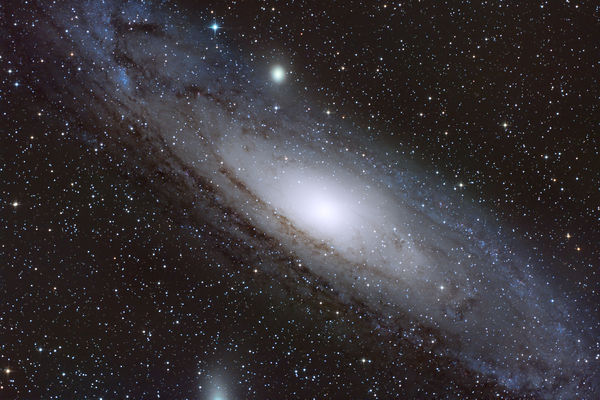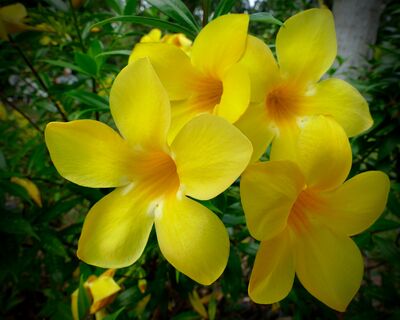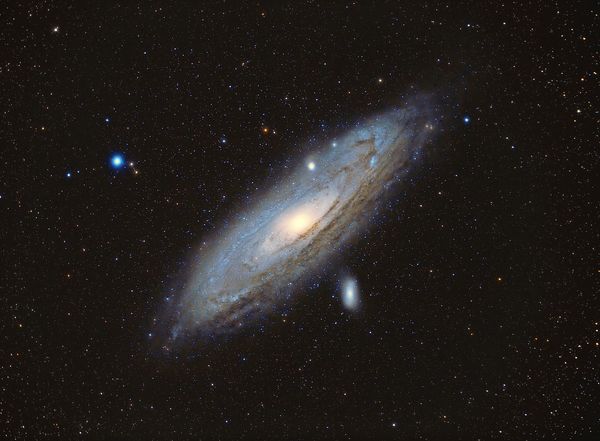Again
Oct 9, 2016 11:50:43 #
Matthew was all but gone from our area - I started setting up about 7 last night - still very cloudy but the clearing skies were promised by my weather software. By 10 the stars were out and all look promising. According to the website "Clear Sky Chart" seeing was rated "BAD".....by now I am sure that this rating really has little if any affect on an 8 inch Newt - and that is what "Clear Sky Chart" says. The wind was still chirpy and I had to delete 22 images due to what I believe was the gusting wind moving the Atlas Pro.......I was shooting for 90, 150 second subs at ISO 200. I am convinced on my Nikons D810a, and D800e that I use for "up" photography that the best S/N ratio starts with a 200 ISO, when using the F/4 Newt or F/4 Nikon 200x400 lens.
68 subs, 200 flats (shot this morning), 20 darks, 80 bias went into this pic. I used PixInsight for 99 percent of the post. I set a curve in PSCC which is essentially what I have been doing for the last few M31's.
If anyone wants to try their hand at processing this data.....I can put the files in a dropbox folder and email you sharing privileges. Just PM me with your email address and let me know if you want the "already calibrated, stacked, and registered" tiff file....or if you want all of the flats, darks, bias, and subs. No matter but the later will take a few hours to upload and then download. But the fun is in the playing around.
68 subs, 200 flats (shot this morning), 20 darks, 80 bias went into this pic. I used PixInsight for 99 percent of the post. I set a curve in PSCC which is essentially what I have been doing for the last few M31's.
If anyone wants to try their hand at processing this data.....I can put the files in a dropbox folder and email you sharing privileges. Just PM me with your email address and let me know if you want the "already calibrated, stacked, and registered" tiff file....or if you want all of the flats, darks, bias, and subs. No matter but the later will take a few hours to upload and then download. But the fun is in the playing around.
Oct 9, 2016 12:05:26 #
Major wow factor on this, super job on this!
Glad Mathew didn't beat you up.
Glad Mathew didn't beat you up.
Oct 9, 2016 16:30:52 #
Great job, can't wait to see it under good conditions. Looks like you need a bigger sensor, did you crop it much?
Oct 9, 2016 17:12:57 #
Also, have you ever used older photos and just add the newer exposures to it? It would be nice to add some more exposure time to mine instead of always starting over. Do the angles change by season at all? I did mine in July, I'm assuming too far away for the angles to have any affect.
Oct 9, 2016 18:18:02 #
Europa wrote:
Great job, can't wait to see it under good conditions. Looks like you need a bigger sensor, did you crop it much?
Crop.....sorta. I have an election I can make "in camera" to use the "crop sensor" mode. Both of my DLSR's D810a and D800e are full frame ..but I can select the "Crop" mode in the menu of choices. This allows photographers who have DX (crop lenses) the ability to use both DX and FX lens. But, in my case...and my reason for choosing "crop mode" pertains to the reduction in the RAW file size...from over 40 mb (full frame), to 15 to 20mb depending on image. This election really speeds up the processing time. Especially when I am using 400 plus images - subs plus supporting files. I am throwing away a lot of data - but when using full frame, I end up needing a crop in post to rid myself of distortion and vignetting in the corners.
So the image has been cropped, in camera. But, I did not crop in post. In fact - I really need to shoot full frame so I can get the ENTIRE galaxy in the frame......
I plan on dragging out my Atik 383L CCD camera and will continue working on M31.
Oct 9, 2016 18:39:44 #
Europa wrote:
Also, have you ever used older photos and just add the newer exposures to it? It would be nice to add some more exposure time to mine instead of always starting over. Do the angles change by season at all? I did mine in July, I'm assuming too far away for the angles to have any affect.
They do change....but framing is an art that I have yet to master. In the case of this image.....I had to rotate the camera 90 degrees to get the elongation of the Galaxy to reach from corner to corner. I am a BIG believer in Astrotortilla for plate solving. I often use data taken over a period of several nights and if I had a permanent observatory - I would do this routinely. When I use data taken over several nights - it is because my kit has been left up for that time. Astrotortilla is a TIME SAVER. I never...never....never, ever do any alignments.
Here is my process
1) Setup mount - level mount base before ever putting the scope on.....I get it close although it really doesn't matter if it is level or not - but I am anal enough to level it anyway.
2) I polar align by using Polemaster - takes 5 minutes tops
3) I boot up either Stellarium or Cartes du Ciel (my favorite to us) and pick a bright star high in the sky and use CDC to slew to it. I do a rough focus which is needed for Astrotortilla to work.... I might add, rarely is the target star in the frame. Then I boot up Astrotortilla - and select SOLVE. It takes anywhere from 30 to 60 seconds but it will center the star - DEAD CENTER.
4) Now that I have a bright star in the frame.....I now refine my focus either using a Bahtinov mask or FWHM on Backyard EOS for Nikon.
5) If i am planning on shooting Andromeda - I will make active, Cartes du Ciel (CDC) and select M31 and slew to it. Then to make sure it is centered, I make active Astrotortilla and "SOLVE". Walla, M31 will be centered.
6) If guiding and at 150 second exposures I will...I make active PhD2 - I will make active the camera, mount, and calibrate. This was an important discover for me.....once PhD2 starts doing it's thing - I go TOOLS>MANUAL GUIDE - then I press on North 3 times and nudge the scope by 3 pulses....and I do West three times and nudge the scope west three pulses. This helps to move the mount's gears in the direction to minimize backlash. Then is selecte TOOLS>GUIDING ASSISTANT and select START. I let it run until I see where my polar alignment error is less than 1.5 arc sec. Then I let the assistant create the needed adjustment recommendations for backlash. Sounds complicated but it isn't.....once you start Phd2 and select those options you will see what I mean. At any rate, I accept their recommendations and apply them.
7) I start imaging - keep in mind that your target will move slightly from it's centered position because you nudged the mount using the Tools>Manual mode.
From starting polar alignment to imaging is 20 to 30 minutes.....prior to Astrotortilla it was an hour or so to get stuff working right....with alignment and finding targets my biggest time consuming issue.
Oct 9, 2016 18:39:54 #
Cool looking forward to seeing how much more of the Galaxy you can still pull in.
Oct 9, 2016 18:45:08 #
nikonshooter wrote:
They do change....but framing is an art that I hav... (show quote)
Interesting, I'll have to try some of this out tonight.
Oct 9, 2016 19:13:08 #
nikonshooter wrote:
They do change....but framing is an art that I hav... (show quote)
Also, I've heard the term plate solving, Sonia that what it does, adjustments for angle and such?
Oct 9, 2016 20:30:46 #
Europa wrote:
Also, I've heard the term plate solving, Sonia that what it does, adjustments for angle and such?
It will center the target, that's it. - but - is uses a model of the sky which also moves with the target so it should align the same regardless of when you are shooting .....if you are shooting over a series of nights, no problem - the angle of view would be so slight if even noticeable....the stacking software will sort that out.
I believe the term plate solving comes from the early days of astro imaging when plates were used. Somehow, the would line the plates up so successive nights of images could be layered one on top of the other and processed. Even that is before my time.
Oct 9, 2016 20:45:02 #
WOW!
So excellent, Ed!
I might have found an answer for me. I set up, then go out in the wee-wee hours and plug away at Orion while everybody is sleeping.
So excellent, Ed!
I might have found an answer for me. I set up, then go out in the wee-wee hours and plug away at Orion while everybody is sleeping.

Oct 10, 2016 21:15:36 #
Oct 11, 2016 14:52:34 #
nikonshooter wrote:
Matthew was all but gone from our area - I started... (show quote)
I can see no reason to try to best this shot Ed it's a great one already.
Craig
Oct 11, 2016 16:06:17 #
CraigFair wrote:
I can see no reason to try to best this shot Ed it's a great one already.
Craig
Craig
Unfortunately, I have taken a pic of M31 that is better, IMHO....I did this two years ago right after I got the D800e modded with a Vixen Ed81s refractor and iOptron ZEQ mount. I don't really recall how good the seeing conditions were at the time I just got good data and did this from my front porch. I am attaching that pic. So, until I can get back to that image - I plan on pressing on with the Newt F/4.
Oct 11, 2016 17:50:41 #
nikonshooter wrote:
Unfortunately, I have taken a pic of M31 that is better, IMHO....I did this two years ago right after I got the D800e modded with a Vixen Ed81s refractor and iOptron ZEQ mount. I don't really recall how good the seeing conditions were at the time I just got good data and did this from my front porch. I am attaching that pic. So, until I can get back to that image - I plan on pressing on with the Newt F/4.
I think you are right Ed it's going to hard to beat this one.
It looks like a professional job to me.
Craig
If you want to reply, then register here. Registration is free and your account is created instantly, so you can post right away.







